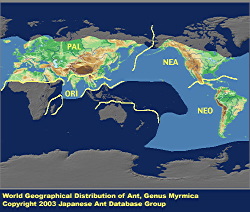
|
genus
|
Myrmica
|
 |

|
|
Japanese Name
|
Kushike-ari-zoku
|
Original Reference
|
|
Latreille, P.A. (1804) Tableau m?thodique des insectes. Classe huiti?me. Insectes, Insecta. Nouveau Dictionnaire d'Histoire Naturelle 24: 129-200.
|
Synonym
|
|
Dodecamyrmica Arnoldi, 1968,
Paramyrmica Cole, 1957a,
Sifolinia Emery, 1907,
Symbiomyrma Arnoldi, 1930c,
Sommimyrma Menozzi, 1925d,
|
Description
|
|
Monomorphic ants with medium-sized workers. Considerable variation in body size is found even among workers of single colonies. Head nearly oval in lateral view. Mandibles subtriangular; masticatory margins with 6 - 10 teeth which decrease in size towards the base. Palpal formula 6:4. Frontal carinae short, not extended posteriorly. Antennae 12-segmented. Antennal funiculus forming a club of 3 to 4 segments, though the degree of thickening varies. Antennal scape usually surpassing posterior border of head; in many species strongly bent or with lamellar extension near the base. Eyes of medium size, situated anterior to midlength of head. Promesonotal suture indistinct dorsally. Metanotal groove more or less impressed. Propodeum with a pair of spines. Mid- and hind legs each with one tibial spur, which is usually pectinate, often essentially simple, or even lacking. Subpetiolar process small, situated anteroventrally.
|
|

|
Remarks
|
|
Bolton (1988) reexamined Myrmica, and included Paramyrmica Cole, Sommimyrma Menozzi and Sifolinia Emery as junior synonyms. These were formerly treated as good genera to include species parasitic on Myrmica. In Myrmica 15 species are known to be inquilines or "guest parasites" of other congeneric species; many of them are workerless. Taxonomic understanding of Myrmica species, including those of Japan, is not yet satisfactory. Judging from recent literature (Bolton, 1988; Kutter,1977; Agosti & Collingwood, 1987; Collingwood, 1970; Kupianskaya, 1986;Allred, 1982; MacKay et al., 1988), 60 or more species are present in the Palaearctic region and about 20 in the Nearctic. We listed 6 species in "A List of Japanese Ants with Common Japanese Names", but here we recognize 8 species, adding 2 which are nomenclaturally undetermined (sp. 7 and sp. 8; Japanese names: Kado-kushike-ari and Kita-kushike-ari), as a result there are 4 determined and 4 undermined species known from Japan.
|
References
|
|
- Arnol'di, K.V. 1968. Vazhnye dopolneniya k mirmekofaune SSSR i opisanie novykh form. Zoologichesky Zhurnal, 47: 1800-1822.
- Cole, A. C., Jr., 1957
- Emery, C. 1907. Una formica nuova italiana spettante ad un nuovo genere. Rend. Sess. R. Accad. Sci. Ist. Bologna, (n.s.)11: 49-51.
- Arnol'di, K. V. 1930. Studien YNber die Systematik der Ameisen. VI. Eine neue parasitische Ameise, mit Bezugnahme auf die Frage nach der Entstehung der Gattungsmerkmale bei den parasit?ren Ameisen. Zool. Anz., 91: 267-283.
- Menozzi, C. 1925 ("1924"). Res mutinenses. Formicidae (Hymenoptera). Atti Soc. Nat. Mat. Modena, 55[=6)3]: 22-47.
- Bolton, B. (1988). A new socially parasitic Myrmica, with a reassessment of the genus (Hymenoptera: Formicidae). Syst. Ent., 13, 1-11.
- Kutter, H. (1977). Hymenoptera, Formicidae. . Insecta Helv. Fauna, 6, 1-298. .
- Agosti, D. & C. A. Collingwood (1987). A provisional list of the Balkan ants (Hym. Formicidae) with a key to the worker caste. II. Key to the worker caste, including the European species without the Iberian. Mitt. Schweiz. Ent. Ges., 60, 261-293.
- Collingwood, C. A. (1970). Formicidae (Hymenoptera: Aculeata) from Nepal. . Khumbu Himal, 3, 371-388.
- Kupianskaya, A. N. (1986). Ants (Hymenoptera, Formicidae) of the group Myrmica lobicornis Nylander from the Far East. InIn P. A. Ler, ed., "Systematics and ecology of insects from the Far East" (pp. 83-90). Akademiya Nauk SSSR, Vladivostock.
|
Editor
|
|
Original text by Keiichi Onoyama and Rikio Sonobe. English translation by Keiichi Onoyama, edited by Robert W. Taylor.
|
|